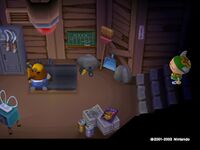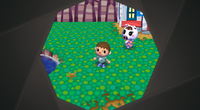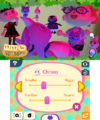Difference between revisions of "Photo (screenshot)"
AlexBot2004 (talk | contribs) m |
AlexBot2004 (talk | contribs) |
||
| Line 5: | Line 5: | ||
===In {{DnMe+|nolink}}=== | ===In {{DnMe+|nolink}}=== | ||
[[File:SurveilanceCenterDnMe+.jpg|thumb|right|200px|A photo taken in {{DnMe+|nolink}}. Note the Nintendo watermark at the bottom-right.]] | [[File:SurveilanceCenterDnMe+.jpg|thumb|right|200px|A photo taken in {{DnMe+|nolink}}. Note the Nintendo watermark at the bottom-right.]] | ||
| − | In {{DnMe+}}, if an SD card is connected to the [[Nintendo GameCube]] via a Memory Card adapter, photos can be taken with the Z button. The resulting screenshot can be saved to the SD card as a 640x480 TIF file with a watermark in the bottom-right corner that reads "©2001-2003 Nintendo". | + | In {{DnMe+}}, if an SD card is connected to the [[Nintendo GameCube]] via a Memory Card adapter, photos can be taken with the Z button. The resulting screenshot can be saved to the SD card as a 640x480 TIF file with a watermark in the bottom-right corner that reads "©2001-2003 Nintendo". Photos on the SD card can be viewed in-game if "SD card" is selected in the startup menu. |
===In {{CF|short|nolink}}=== | ===In {{CF|short|nolink}}=== | ||
Revision as of 01:23, October 24, 2020
Photos, also known as pictures, are in-game screenshots that can be taken in Doubutsu no Mori e+, Animal Crossing: City Folk, Animal Crossing: New Leaf, and Animal Crossing: New Horizons. A photo can be taken at almost any time during gameplay.
Appearances
In Doubutsu no Mori e+
In Doubutsu no Mori e+, if an SD card is connected to the Nintendo GameCube via a Memory Card adapter, photos can be taken with the Z button. The resulting screenshot can be saved to the SD card as a 640x480 TIF file with a watermark in the bottom-right corner that reads "©2001-2003 Nintendo". Photos on the SD card can be viewed in-game if "SD card" is selected in the startup menu.
In City Folk
In Animal Crossing: City Folk, a photo can be taken by pressing the 1 button on the Wii Remote. The photo will capture everything shown on the screen at that time, including HUD elements such as the clock. To instantly view the photo, the 2 button can be pressed. The photo can then be saved to an SD card. The game will store only one photo at a time, and each new photo will erase the one previously taken. To save multiple photos, each one must be saved to the SD card before taking another photo. The resulting screenshot is saved as a 896x480 or 640x480 JPG file, depending on the Wii's set aspect ratio.
As City Folk predates the Wii System Update allowing for high-capacity storage, the game only supports SD Cards up to 2 GB. SD Cards that exceed 2 GB or are SDHC/SDXC cards will be considered an "unknown device" by the game and cannot be used to save pictures.
In New Leaf
In Animal Crossing: New Leaf, a photo can be taken by pressing the L and R buttons simultaneously, and will capture any HUD elements displayed on the screen at the time of the photo. Only the top screen will be captured—it is not possible to take a photo of the touch-screen without using third-party software. It is also not possible to take a photo in certain areas. All photos are saved on the SD Card as 400x240 JPG files, and thry can be viewed in the Nintendo 3DS Camera application.
The Nintendo 3DS has a limit of 3,000 photos that can be stored. When the limit is reached, a warning will be displayed saying that the player is no longer able to take photos.
amiibo Camera
The amiibo Camera is a feature introduced in Animal Crossing: New Leaf - Welcome amiibo that has similar functionality to the Nintendo 3DS Camera but adds the ability to add villagers currently in town, including the player. The user can also add villagers using the amiibo feature by tapping their respective card or figurine. Once in the canvas, their position, rotation, size, and depth can be changed, as well as the image's lighting, canvas, and timestamp. The villagers' outfits are the ones they wear by default and cannot be changed, while the players' are their outfits during gameplay.
The amiibo Camera remembers which villagers have been there and their positions and emotions, and, after moving out, they will still appear in the application until they get removed by the user. The only way to reintroduce them is to scan their respective amiibo, or make sure they reappear in town.
In New Horizons
In Animal Crossing: New Horizons, players can take a screenshot by pressing the Capture button on the Joy-Con or Pro Controller like any other Nintendo Switch game. However, on the NookPhone, there is a designated photo app unlocked from the start. Players can add several different filters and borders to customize their screenshots and take a screenshot with the + button. The resulting screenshots are saved to the Nintendo Switch's photo album as 1280x720 JPG files, regardless of whether the Switch is in Handheld or TV Mode. Beginning in version 1.4.0, the HUD during photo mode can be hidden by pressing in the R Stick.
A new addition to New Horizons is Harv's Island, where the player can arrange various sets with props and villagers. These villagers can be residents from the player's island, or they can be characters scanned in via amiibo.
Gallery
- NF-No-Photos.jpg
A player unable to take a photo in New Leaf.
- AC Amiibo - Photo Feature preview 2.jpg
A demo of the amiibo Camera in Welcome amiibo. Note the presence of special characters.
- What happens when a screenshot is taken in a game cartridge without the SD card?
- Add Happy Home Designer information
- What happens when a screenshot is taken in a game cartridge without the SD card?
- Add Happy Home Designer information
| Gameplay elements | ||||||||||||||||||||||||||
|---|---|---|---|---|---|---|---|---|---|---|---|---|---|---|---|---|---|---|---|---|---|---|---|---|---|---|
| ||||||||||||||||||||||||||






